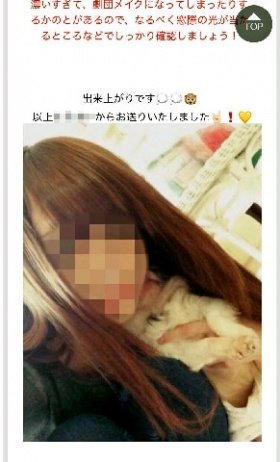“It’s Me in the Picture of Spam”—Stealing Selfies from Blogs and Flipping Photos to Stay Hidden/迷惑メールを追う3
“Uncover the Truth Behind Spam” Part3
We were contacted by a reader of Part 2: “Uncover the Truth Behind Spam”. In the article, we introduced how we responded to a spam message that included a picture of a woman claiming to be a 22-year-old working at a café. Seeing this article, one of our readers thought, “The girl in this picture looks like my daughter.” It appeared that a picture from her blog had been stolen. The spammer used a certain “trick” to stay hidden.
Our Special Mission News Crew reached out to Ms. Ayami (21, alias) . “That is definitely me,” the college student said, as she identified herself in a picture from a year or two ago. “I post selfies almost daily as a hobby.” Her blog’s privacy settings allowed anyone to see her posts.

Original Photo Stolen from Ms. Ayami’s Blog where She Introduces Makeup Techniques
Other online dating websites also maliciously used her photos. Her friends and Twitter follows had pointed out repeatedly, “Isn’t this you, Ayami?”
Spam messages that said “Hi, I’m Yuko” and “Let’s meet up” try to lure people to suspicious websites. “They make it seem like I’m doing something bad. I really wish they would stop doing this.”
Comparing the photo of Ayami from her blog with the photo used in the spam message, we realized that the original picture had been mirrored. Ayami wondered, “Do they do this to keep from getting found in image searches?”
■
Image searches such as Google allow users to copy, paste, and search for images to find websites that the pictures are posted on. It is not uncommon for photos used in spam messages to originate from other online posts.
According to an employee at a large IT firm, image searches utilize an algorithm that identifies similar colors and lines. “Although a person would be able to easily identify these as the same picture that had been mirrored, the search engine doesn’t recognize the similarity. In theory, the image search should not provide an appropriate result.”
Flipping the axis of a picture is a systematic blind spot. Both the victim who had their photo stolen and the person who received the picture would have difficulty identifying suspicious practice, which is ideal for the sender.

Selfie from Personal Blog (edited to protect privacy)

Photo from Spam Message (edited to protect privacy)
We experimented with another spam message picture from a person named “Sarara”. There were no results when searching for the image we received. But when we searched for the same photo after simply flipping the picture on our computer, we were led to a website. The search result showed the women in the photo was a model.
We contacted her modeling agency. The picture was stolen from her personal Instagram account. They were aware that her photo had been used for brothel advertisements, but it was the first they heard of her photo being using for spam. Her agent sighed and said, “We can’t identify who did this so we will just have to suck it up.”
■■
Flipping photos on their axis is a problem across the globe. The Brazilian ‘surfing war photographer' accumulated 120,000 followers on Instagram before being exposed as a fraud. Before posting the photos, he had inverted and edited photos shot by actual photographers working in Iraq.
What legal repercussions are involved in stealing photos and using them for spam. On one hand, it could be argued that people have no say in what happens after posting their photos on a public platform such as the internet. Fukuoka University Faculty of Law, Associate Professor Takashi Jitsuhara (public law and information law) said, “That is not entirely true.” He argues that victims can sue such malicious vendors for compensation by claiming slander and violating rights to use images of one’s likeness.
Considering the financial cost and time invested in filing a suit, “It may be better to avoid publicly posting pictures of your face,” he concludes.
迷惑メールの写真は私 業者がブログの自撮り盗用 左右反転させ発覚避ける
「迷惑メールの写真の女性は娘ではないか」-。顔写真付きの迷惑メールを記者に送ってきた「22歳のカフェ店員」に返信し、やりとりを報告した迷惑メールを追うPart 2: “Uncover the Truth Behind Spam”. 。記事を読んだ女性の家族から問い合わせがあった。ブログの写真が盗用された疑いがあるという。迷惑メール送信業者は発覚を避けるためか、ある「仕掛け」をしていた。
特命取材班は、本人に話を聞いた。兵庫県の会社員あやみさん(21)=仮名。「この写真は確かに私です」。短大生だった1、2年前の写真という。「趣味みたいな感じで、毎日のように自撮りした写真を載せていました」。ブログは誰でも閲覧可能な設定だった。

自撮り写真が盗用された、あやみさんのブログ。メイク方法などを紹介していた
実は、これまでも出会い系サイトに写真を悪用されたことがあった。「この写真、あやみちゃんじゃない?」。ツイッターのフォロワー(読者)や友達から何度も指摘された。
「私、優子」と名乗った今回の迷惑メールも、「遊ぶ約束をしたい」と怪しげなサイトに誘導する内容だった。「私が悪いことをしているみたいで嫌だし、やめてほしい」と言う。
あやみさんから実際にブログに載せた写真を見せてもらい、迷惑メールの写真と見比べてみると-。なんと、左右が反転していた。「インターネットの画像検索に引っかからないようにするためかな」とあやみさん。どういうことか。

ブログの自撮り写真(写真の一部を加工しています)

迷惑メールの写真(写真の一部を加工しています)
■■■
画像検索は、グーグルなどの検索サイトで調べたい画像をコピーして貼り付けると、その画像が掲載されているページが表示される。迷惑メールに盗用された写真は、ネット上に流出しているケースが少なくない。
大手IT企業の社員によると、画像検索のシステムは、線や色などから推測して似たような画像を見つけるようプログラムされている。このため「人間の目なら左右に反転処理された画像でも同じものと判別できるが、コンピューターは別の画像と認識してしまう。理論的に今回のケースでは検索に引っかからないのではないか」と打ち明ける。
左右反転処理はシステム上の「盲点」。写真を盗用された被害者、迷惑メールの受信者いずれにも発覚しにくく、送信業者にとって都合がいいとみられる。
別の迷惑メールに添付された「さらら」と名乗る女性の写真で実験してみた。そのまま画像検索しても何も出てこない。パソコンで簡単にできる左右反転処理をして再び検索すると、あるサイトが出てきた。写真の女性はモデルだった。
女性が所属する都内の芸能事務所に一報した。盗用されたのはモデル自身の写真共有アプリ「インスタグラム」から。風俗店の宣伝などに盗用されたことはあったが、迷惑メールは初めてという。事務所関係者は「犯人を追いきれず、泣き寝入りするしかない状態」とため息をつく。
■■■■
写真の反転は、海外でも問題化している。インスタグラムで約12万人ものフォロワーが付いていた「ブラジル人の戦場カメラマン」が昨年、実在しない人物と判明した。投稿された写真は、イラクなどで活動する写真家の作品の盗用だったが、編集・反転加工されているため発覚しなかった。
迷惑メールへの写真盗用には法律的にどんな問題があるのか。ネット上では自分の意思で公表した写真だからどう使われようと仕方ないという見方もあるが、福岡大の實原隆志准教授(憲法・情報法)は「そうとは言い切れない」。肖像権侵害や名誉毀損(きそん)を主張して送信業者に損害賠償を請求できるという。
ただ、訴訟となると労力やコストがかかる。「みだりに顔写真を公表しない方がいいかもしれません」と話した。
Wow..... what are the odds of that young girl's mother seeing that post.😫 What luck